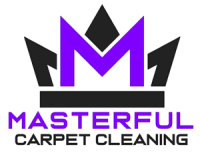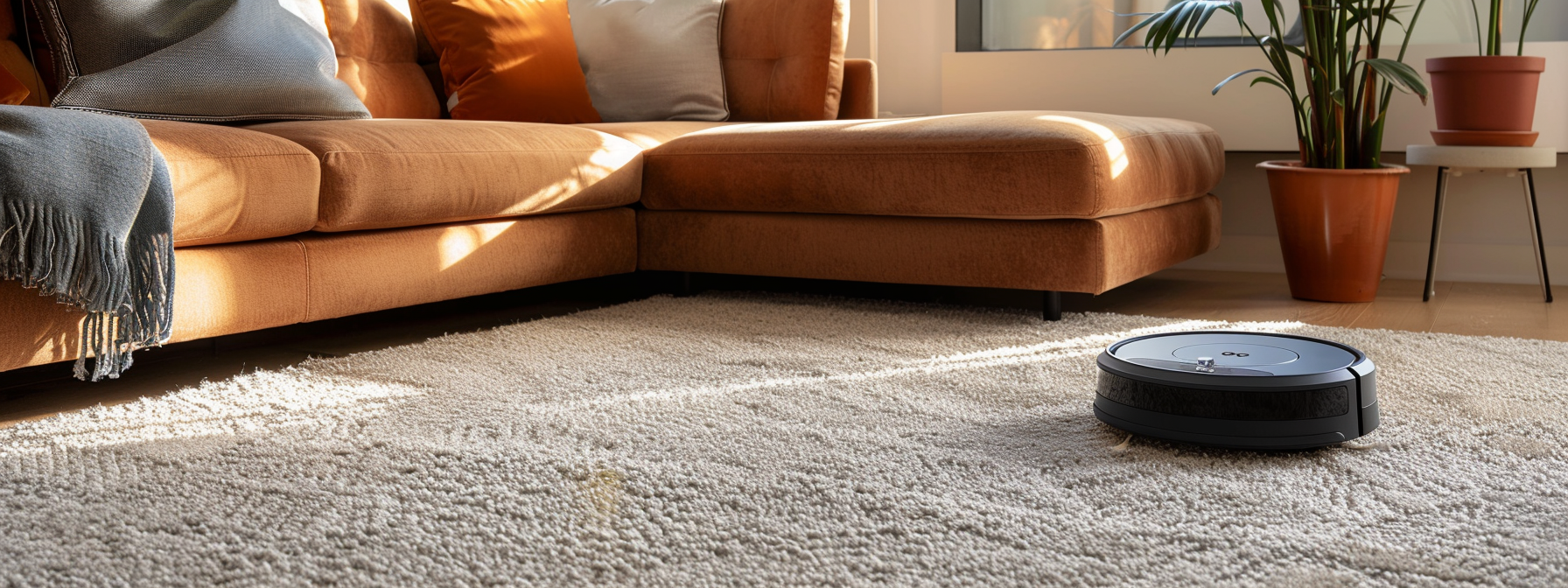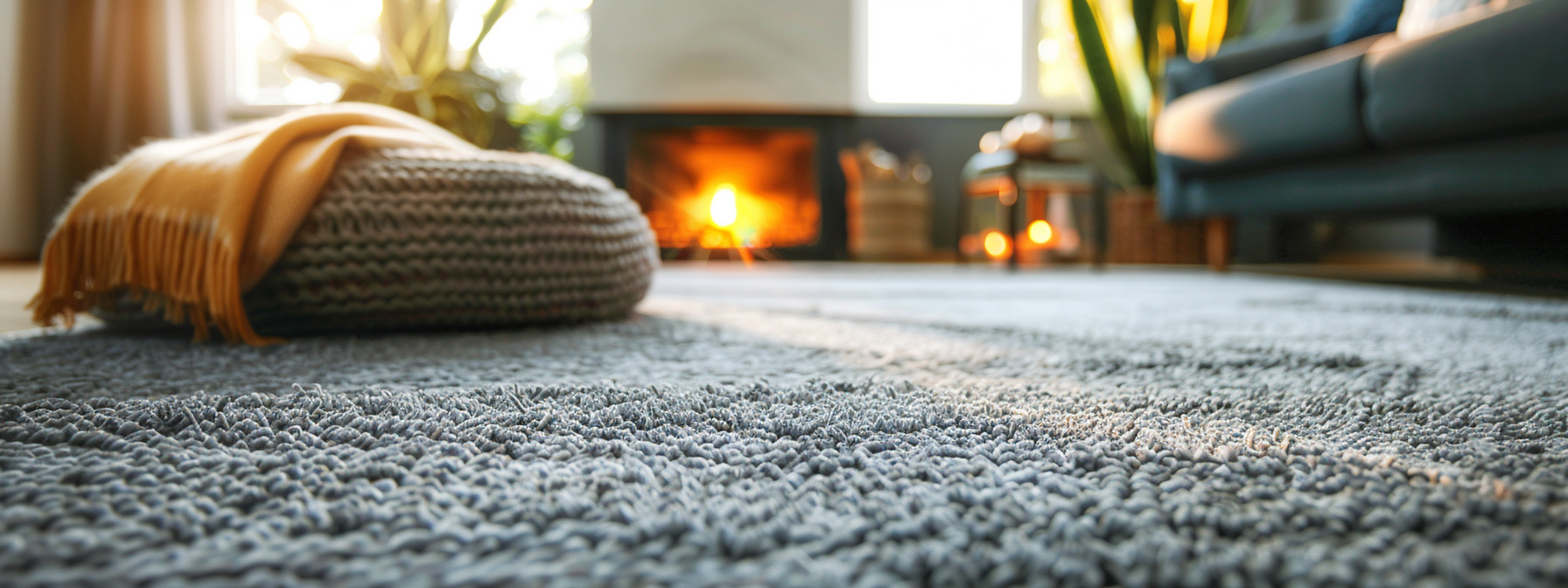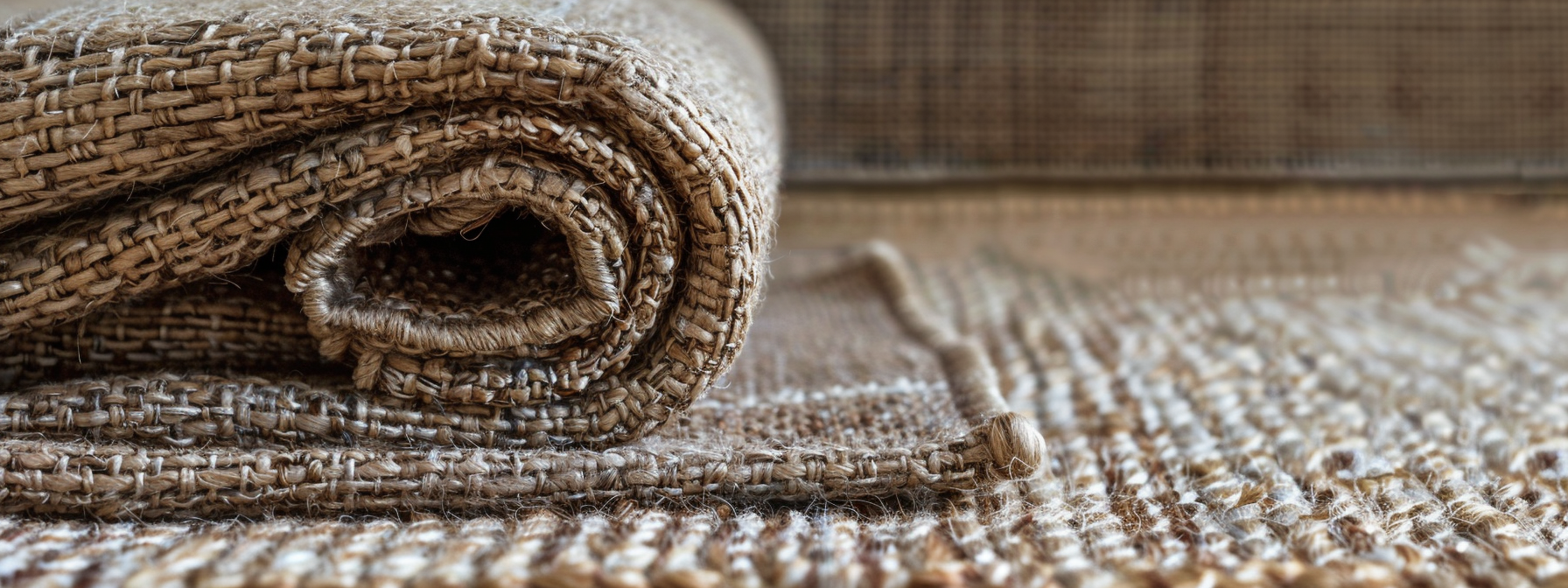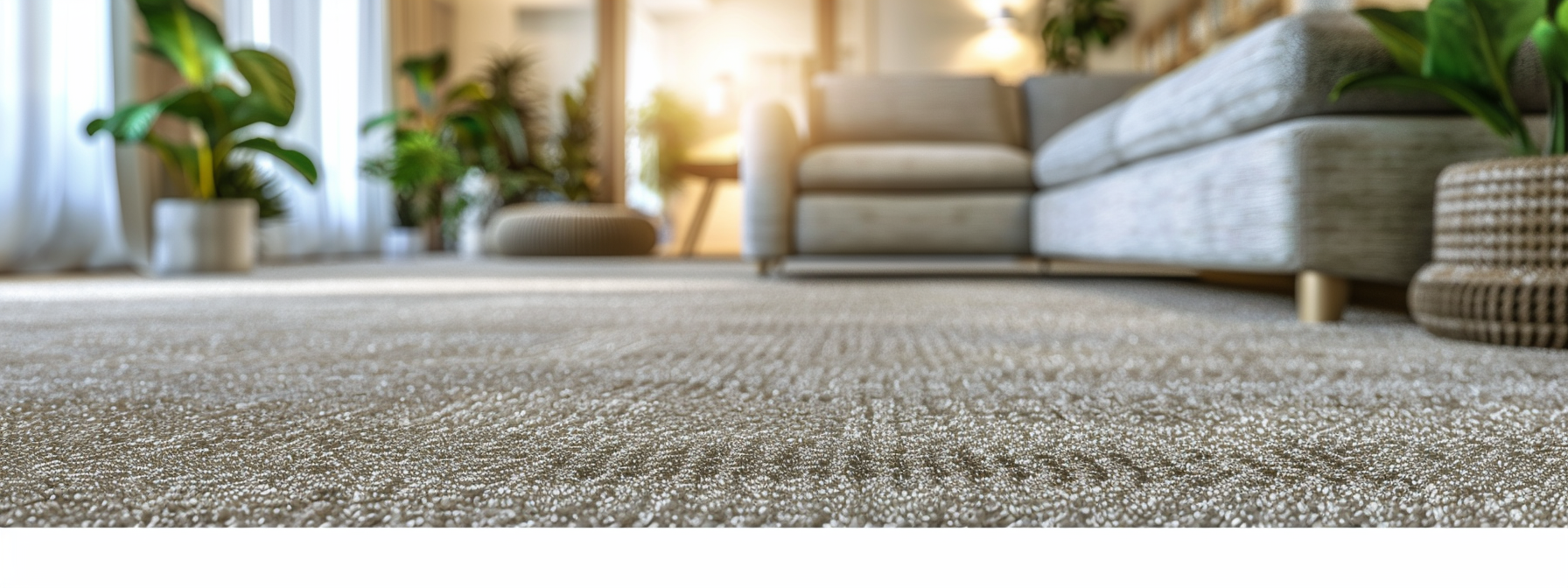Tile Floor Cleaning: Tips and Tricks for a Spotless Surface
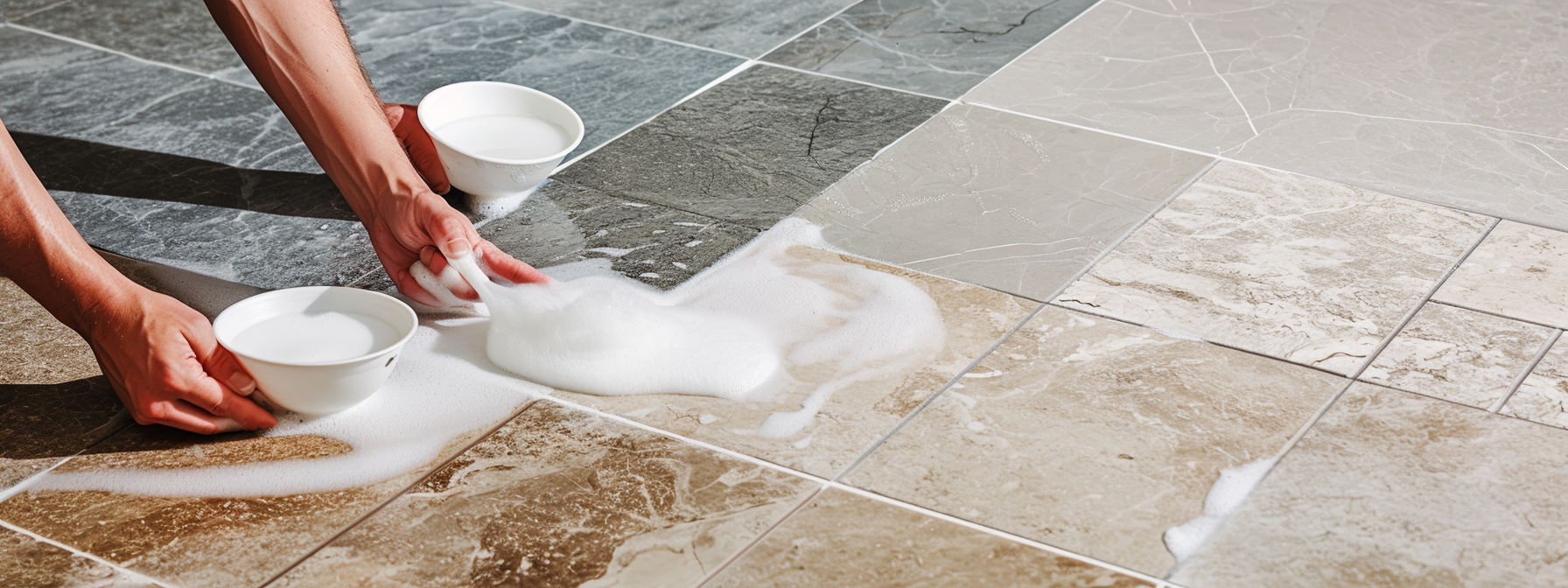
Tile flooring, celebrated for its beauty and low-maintenance nature, is a prevalent choice for bathrooms, kitchens, and various spaces.
The key to preserving its elegance lies in routine care and understanding the specific needs of different tile types.
Regular Cleaning: The First Step to Pristine Floors
Regular sweeping or vacuuming forms the cornerstone of tile floor maintenance, effectively preventing dirt and debris accumulation.
This simple yet important practice safeguards the tiles from scratches and maintains their pristine condition.
It’s especially important to address spills immediately, as prompt action can prevent staining, particularly on porous tiles like natural stone.
Tailoring Cleaning to Tile Type
Different tile materials—ceramic, porcelain, natural stone, and glass, each demand a specific approach to cleaning.
For example, porous natural stone tiles like marble or limestone may require pH-neutral cleaners and should be sealed to guard against stains.
Ceramic and porcelain tiles, known for their moisture resistance, can often be cleaned with simpler methods.
Grout Consideration: A Key Aspect of Tile Care
Grout plays a key role in tile aesthetics and integrity. It should be regularly inspected and maintained to prevent water penetration and potential tile damage.
Proper grout care ensures a seamless and clean appearance, highlighting the tiles’ beauty.
Preventive Measures for Long-Term Beauty
In addition to routine cleaning, preventive strategies like using doormats in high-traffic areas and employing furniture protectors can significantly prolong the life and appearance of tile floors.
These measures help minimize wear and tear, keeping the tiles looking new for longer.
A Commitment to Regular Care
Tile floor cleaning is not just about aesthetics; it’s about preserving the material’s integrity and ensuring a hygienic environment.
By adhering to a regular cleaning schedule tailored to the specific tile type and paying attention to details like grout maintenance and preventive measures, one can ensure that their tile floors remain a beautiful and durable aspect of their home for years to come.
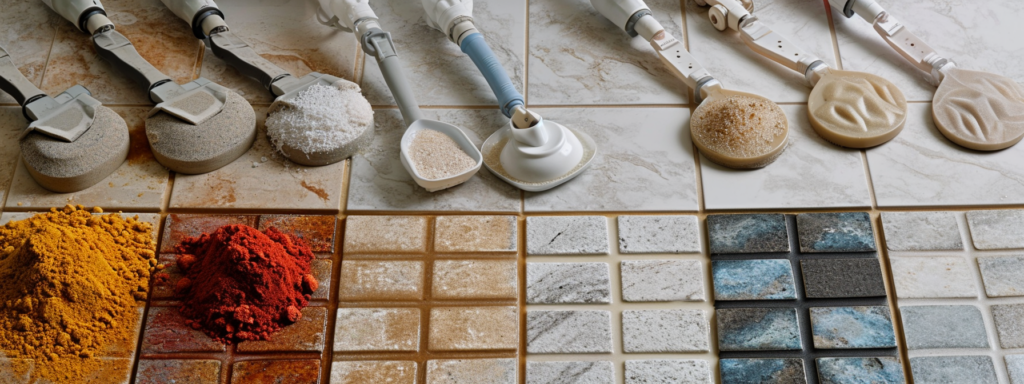
The Diverse Range of Tile Flooring
Tile floors, a cornerstone in modern architecture, offer a plethora of options each with unique characteristics and aesthetic appeals.
Ceramic Tiles: Versatile and Durable
Ceramic tiles, made from molded clay materials and hardened at high temperatures, are a popular choice for their durability and versatility.
Available in both glazed and unglazed forms, they are scratch, stain, and water-resistant, making them ideal for any room.
Porcelain Tiles: Elegance with Ease
Porcelain, a type of ceramic but denser and less porous, is known for its ability to mimic natural stone or wood.
Resistant to cracking and fading, porcelain is suitable for both indoor and outdoor use, offering an elegant finish with minimal upkeep.
Glass Tiles: For a Touch of Sophistication
Glass tiles stand out for their stain resistance and aesthetic appeal. Typically used in low-traffic areas, they offer a range of shapes and sizes, including mosaic options.
Their susceptibility to chipping limits their application to specific areas.
Vitrified Tiles: A Robust Alternative
Vitrified tiles, known for their low porosity and high durability, are a cost-effective alternative to natural stones like granite. T
hey are suitable for both indoor and outdoor use, offering easy maintenance and a bright, shimmering appearance.
Mosaic Tiles: Artistic and Eco-Friendly
Mosaic tiles, known for their decorative quality, are assembled from small tile pieces, offering flexibility in design.
They are durable, easy to maintain, and environmentally sustainable, best suited for areas with low foot traffic.
Vinyl Tiles: Practical and Affordable
Vinyl tiles, preferred for their durability and resistance to water and stains, are a practical choice for high-traffic areas.
They replicate the look of more expensive materials like ceramic or wood and are relatively easy to install.
Exploring Natural Stone Tiles
Natural stone tiles, each with distinct features, add elegance and character to spaces:
- Onyx: Soft and lightweight, onyx tiles offer a luxurious look, suitable for kitchens and bathrooms. They require careful maintenance due to their porosity.
- Granite: Highly dense and durable, granite is ideal for high-traffic areas. Its polished surface is almost impervious and scratch-resistant, though it can be cold underfoot.
- Marble: Known for its elegance, marble is best for low-traffic areas like bathrooms. It requires more upkeep and is prone to scratches and stains.
- Limestone: Less dense than marble or granite, limestone is suitable for low foot traffic areas and outdoor spaces. It is prone to scratches and requires sealing.
- Travertine: A form of limestone, travertine has a unique appearance but is not recommended for high-traffic areas due to its porosity and tendency to scratch and stain.
- Slate: Extremely durable and suitable for high-traffic areas, slate tiles add a unique natural beauty to floors. They require regular sealing and maintenance.
- Sandstone: Durable and eco-friendly, sandstone is ideal for high-traffic areas, including outdoor spaces. Its porous nature makes it prone to water absorption and scratches.
A Tile for Every Space
Understanding the distinct properties of each tile type is crucial for choosing the right flooring for your space. Factors like traffic, maintenance, and aesthetic preferences play a significant role in this decision.
With this comprehensive understanding, selecting the perfect tile flooring becomes an informed and rewarding process.
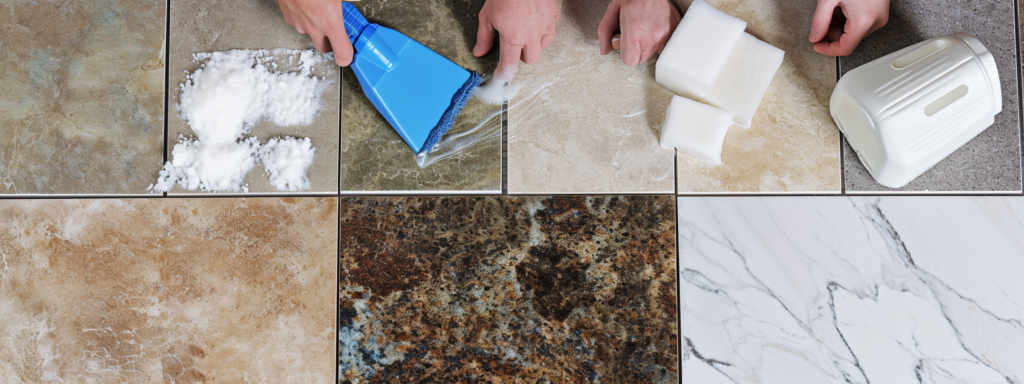
Cleaning Methodology for Tile Floors
Maintaining the pristine appearance and extending the longevity of tile floors requires a specific cleaning approach tailored to the type of tile.
Porcelain and Ceramic Tiles: Easy Care for Durable Surfaces
Porcelain and ceramic tiles are known for their ease of maintenance and durability. The cleaning process involves:
- Debris Removal: Start by sweeping or vacuuming the floor to remove loose dirt and debris, preventing scratches during the cleaning process.
- Cleaning Solution: Mix a mild detergent or pH-neutral tile cleaner with warm water. Avoid harsh chemicals or abrasive cleaners that might damage the tiles.
- Application: Use a mop or soft cloth dipped in the cleaning solution. Wring it out to remove excess moisture before mopping or wiping the tiles. Clean in small sections for thoroughness.
- Scrubbing Stains: Tackle tough stains or grime with a soft-bristle brush or non-abrasive scrub pad, using gentle, circular motions.
- Rinsing and Drying: Rinse the tiles with clean water and dry them using a lint-free cloth, towel, or fan to prevent water spots or mineral deposits.
Natural Stone Tile: Specialized Care for Delicate Surfaces
Natural stone tiles like marble, limestone, and travertine require a careful approach to avoid damage:
- Supplies: Gather a soft-bristle brush or mop, pH-neutral stone cleaner, warm water, and lint-free cloths.
- Sweeping/Vacuuming: Remove any loose surface dirt and dust.
- Cleaning Solution: Dilute a pH-neutral stone cleaner as per instructions. Always use a cleaner formulated specifically for natural stone.
- Test and Apply: Test the cleaner in an inconspicuous area before applying it to the entire floor. Use a soft-bristle brush or mop to apply the cleaner evenly.
- Gentle Scrubbing: Scrub the surface gently, paying special attention to grout lines, and avoid using abrasive tools.
- Rinsing and Drying: Rinse thoroughly with clean water and dry with a lint-free cloth.
- Sealing Consideration: Consider applying a stone sealer for added protection, based on the specific type of stone.
Glass Tiles: Delicate Handling for Lustrous Surfaces
Glass tiles require a gentle touch to maintain their luster and prevent scratches:
- Gathering Supplies: Use a soft cloth or sponge, mild glass cleaner or a vinegar-water solution, and a lint-free cloth for drying.
- Cleaning Solution: Prepare a diluted glass cleaner or a vinegar-water solution. Test it in an inconspicuous area first.
- Application: Spray or apply the cleaning solution, then gently wipe the tiles with a soft cloth or sponge in a circular motion, avoiding abrasive materials.
- Rinsing and Drying: Rinse with clean water and dry with a lint-free cloth to prevent water spots and streaking.
- Regular Maintenance: Dust or wipe down glass tiles regularly to prevent debris buildup and be cautious with textured or frosted glass tiles.
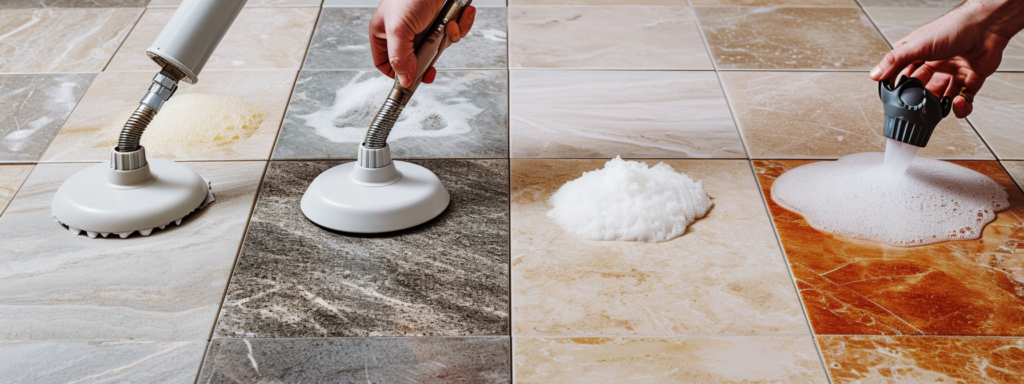
Tailored Approaches for Tile Longevity
Each type of tile flooring requires a specific cleaning methodology to maintain its beauty and structural integrity.
By following these tailored approaches, one can ensure that their tile floors, whether porcelain, ceramic, natural stone, or glass, remain clean, beautiful, and durable for years to come.
Regular care and the use of suitable cleaning products and techniques are essential in preserving the aesthetic and functional qualities of these diverse flooring materials.
Maintenance Tips for Tile Floors
Maintaining tile floors is crucial for preserving their beauty and extending their lifespan.
While different types of tiles may have specific maintenance requirements, certain best practices apply universally to ensure optimal care of your tile floors.
Regular Cleaning Routine
Establishing a consistent cleaning routine is vital to prevent the accumulation of dirt, residue, grease, and other contaminants that can dull or damage tiles.
Regular sweeping or vacuuming is recommended to remove loose debris, followed by mopping with a suitable cleaner. It’s important to use cleaners recommended by the manufacturer and to always rinse the tiles with clean water after cleaning to remove any residue.
Special Considerations for Different Tile Types
- For glazed and unglazed tiles, use clean water and a tile cleaner recommended by the manufacturer. After cleaning, follow up with a clean water rinse to remove all cleaning solutions.
- Tiles with coarse or abrasive surfaces may require more frequent maintenance and vigorous agitation. It’s essential to change the cleaning water frequently to maintain the slip resistance value and avoid creating slippery conditions.
Avoiding Abrasive Cleaners
To preserve the integrity and appearance of the tile, avoid using abrasive cleaners or harsh chemicals.
These can scratch, dull, or deteriorate the tile over time. Non-abrasive cleaners are preferable to maintain the finish and texture of the tiles.
Addressing Grout Maintenance
Grout lines are an integral part of tile flooring and require regular inspection and maintenance.
Keep the grout lines clean and, if necessary, reseal them periodically to prevent water penetration and damage to the tiles.
Protective Measures
To minimize wear and tear, especially in high-traffic areas, use doormats or rugs to trap dirt and prevent it from scratching the tiles.
Regularly clean and shake out these mats to maintain their effectiveness. Using furniture protectors can help prevent scratches and damage from moving furniture.
Preserving the Aesthetic
Adhering to these maintenance tips will help in preserving the aesthetic and functional quality of tile floors.
Regular cleaning, using appropriate products, and taking preventive measures are key to maintaining the longevity and beauty of your tile flooring.
Tailoring your maintenance routine to the specific type of tile you have will ensure the best care and preservation of your flooring investment.
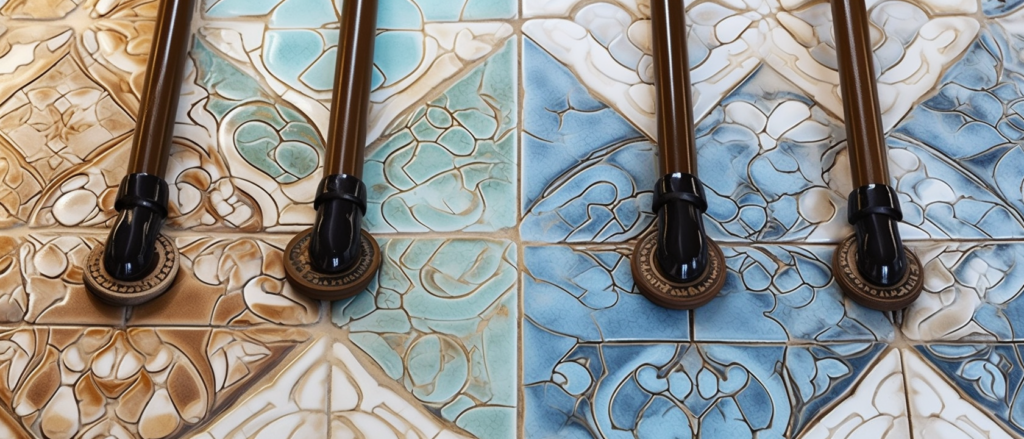
Challenges in Tile Floor Cleaning
Maintaining tile floors often involves confronting a range of challenges that can affect their appearance and longevity.
Dealing with Stubborn Stains
Stains are a frequent challenge in tile maintenance. The key to tackling them is prompt and appropriate action.
For tough stains, such as those from spills of pasta sauce or grease, it’s crucial to identify the nature of the stain and the type of tile affected. Utilizing manufacturer-recommended cleaning agents is essential.
For example, a diluted mixture of warm water and white vinegar can be effective for certain stains on ceramic or porcelain tiles.
Caution is advised with natural stone tiles, where acidic solutions like vinegar can cause damage. Instead, use pH-neutral cleaners specifically formulated for natural stone.
Preventing and Removing Grout Discoloration
Grout discoloration is another common issue. Regular cleaning of grout lines is important to prevent buildup of dirt and grime, which can lead to staining.
For cleaning, use a suitable grout cleaner or a homemade solution, such as baking soda and water, applied with a soft brush.
It’s important to rinse the area thoroughly after cleaning to avoid residue. In cases of severe discoloration, re-grouting might be necessary.
Combatting Mold and Mildew in Wet Areas
Tiles in bathrooms or other high-moisture areas are prone to mold and mildew growth.
Regular cleaning with mold and mildew removers, or natural solutions like a vinegar-water mixture, can be effective. Ensuring proper ventilation in these areas is also key to preventing mold growth.
Minimizing Scratches and Chips
Tiles can be susceptible to scratches and chips, especially in high-traffic areas. To minimize this risk, use doormats or rugs in entryways and avoid dragging heavy furniture across tile surfaces.
For tiles with coarse or abrasive surfaces, more frequent maintenance and careful cleaning are necessary to maintain slip resistance and prevent surface damage.
Addressing Water Damage and Efflorescence
Water damage and the resulting efflorescence (white residue) can be a challenge, particularly for natural stone tiles. Preventing water damage involves ensuring that tiles, especially in wet areas, are properly sealed.
Regularly inspect the sealant and reapply as necessary. If efflorescence occurs, cleaning with a specialized stone cleaner and then resealing the surface can be effective.
Effectively addressing these common challenges in tile floor maintenance requires a combination of prompt action, appropriate cleaning methods, and preventive measures.
By understanding the specific needs of different tile types and employing targeted solutions for each challenge, you can maintain the beauty and durability of your tile floors for years to come.
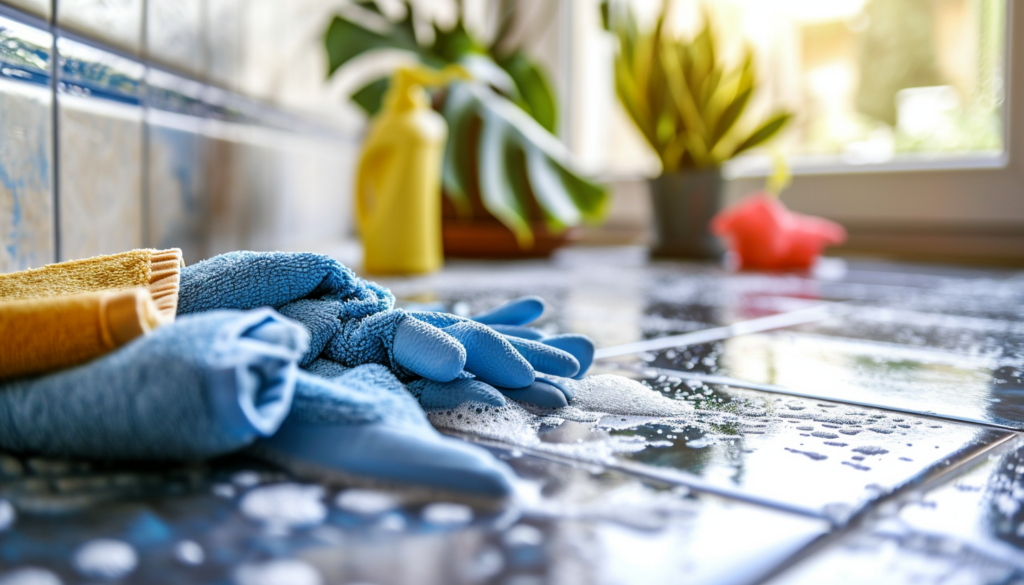
Advanced Cleaning Techniques for Tile Floors
To maintain the aesthetic and functional integrity of tile floors, incorporating advanced cleaning techniques can be highly beneficial.
Deep Cleaning with Steam Mops
Steam mopping is an advanced method particularly effective for durable tiles like porcelain and ceramic.
This technique uses high-temperature steam to loosen dirt and grime without the need for harsh chemicals. It’s especially useful for removing stubborn stains and sanitizing the floor surface.
When using a steam mop, it’s important to follow the manufacturer’s instructions and ensure that the tile material is suitable for this kind of cleaning.
Specialized Solutions for Natural Stone Tiles
Natural stone tiles, such as marble, granite, and travertine, may require specialized cleaning solutions formulated for stone care.
These solutions help to gently remove dirt and stains without damaging the sensitive surface of the stone.
For deep cleaning, it’s advisable to use a soft-bristle brush or a microfiber mop along with the stone-specific cleaner, followed by a thorough rinse with clean water.
Grout Deep Cleaning Techniques
Grout lines are often the most challenging areas to keep clean on tile floors. For a deep clean, using a grout cleaner that’s specifically designed for this purpose can be effective.
For more stubborn grout stains, a mixture of baking soda and water applied with a grout brush can help lift the dirt. After cleaning, it’s important to rinse the area well to prevent residue buildup.
Polishing and Sealing for Longevity
After deep cleaning, polishing, and sealing certain types of tiles, especially natural stone, can enhance their shine and provide an additional protective layer.
Polishing should be done with a product suitable for the specific type of tile. Sealing helps to protect the tiles from future stains and water damage, and it’s particularly important for porous tiles like natural stone and unglazed ceramics.
Addressing Tile Discoloration
Discoloration can occur over time due to various factors, including sun exposure and chemical damage.
To address this, use cleaning products designed to restore the color of the tiles. In some cases, professional treatment may be required to fully restore the original color, especially for natural stone tiles.
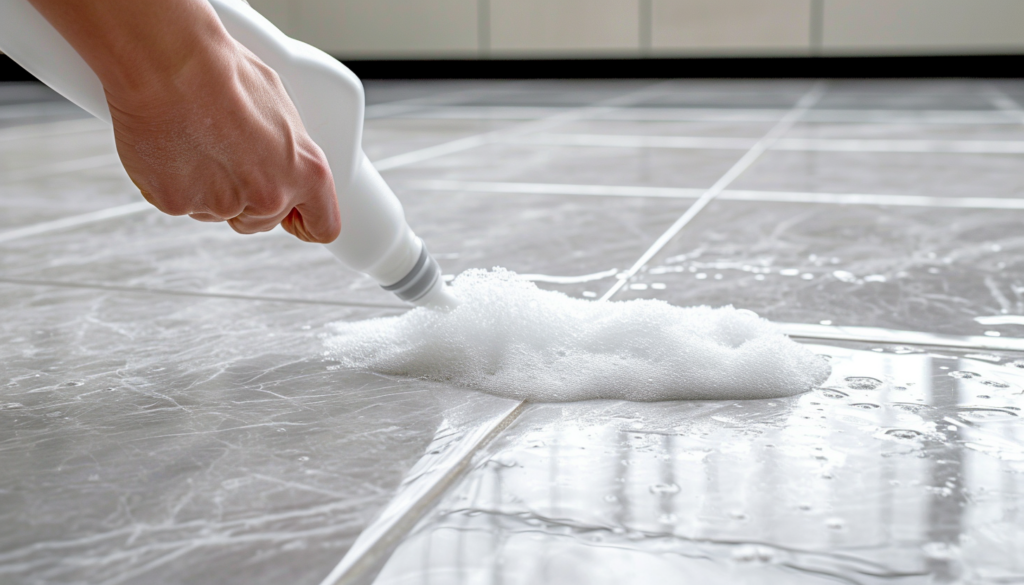
Ensuring Long-Lasting Beauty of Your Tile Floors
The dedication to maintaining your floors not only enhances the beauty of your space but also contributes to a healthier and more pleasant living environment.
Embracing Routine and Advanced Care
Remember, the key to keeping your tile floors in pristine condition lies in a balanced approach that combines routine cleaning with advanced techniques.
Regular sweeping, vacuuming, and appropriate mopping are foundational. At the same time, don’t hesitate to employ deeper cleaning methods, such as steam mopping or specialized solutions for tough stains and grout care, as needed.
Tailored Approach for Different Tile Types
Every tile type, from ceramic and porcelain to natural stone and glass, has unique requirements.
Adapting your cleaning methods to these specific needs ensures that each tile type maintains its unique charm and resilience.
Professional Assistance for Exceptional Results
While the guidelines provided here are designed to equip you with the knowledge to effectively care for your tile floors, sometimes the touch of a professional can make a significant difference, especially for challenging stains or specialized tile types.
At Masterful Carpet Cleaning, we understand the intricacies of tile floor maintenance and offer expert services to bring out the best in your floors. Our team is equipped with the knowledge, tools, and products tailored to treat your specific tile type with the utmost care.
Book Your Professional Tile Cleaning Today
If you’re looking to rejuvenate your tile floors or require professional assistance for more complex cleaning and maintenance, don’t hesitate to reach out to us.
Booking is just a phone call away, and our team at Masterful Carpet Cleaning is ready to provide you with top-tier service to ensure your tile floors look and feel masterful.
Your Tile Floors Deserve the Best
Remember that your tile floors are an investment in your home’s beauty and functionality. By following these guidelines and seeking professional help when needed, you can ensure that this investment continues to pay dividends in the form of a beautiful, durable, and clean living space.
To book a professional tile cleaning service or to learn more about how we can assist you in maintaining the beauty of your tile floors, give us a call today.
We’re here to help you achieve the perfect balance of cleanliness and elegance in your home.
Author
-

As the Co-Owner of Masterful, Randy has been providing quality cleaning services to the Salem and Portland areas of Oregon for many years. He has built a reputation for excellence in the industry. His team take prides in using the latest cleaning techniques and technologies to deliver exceptional results every time.
